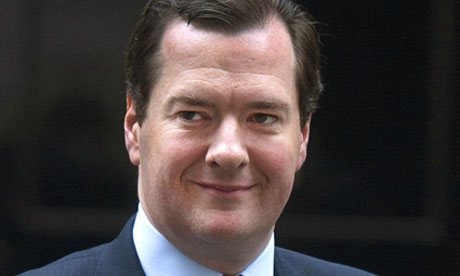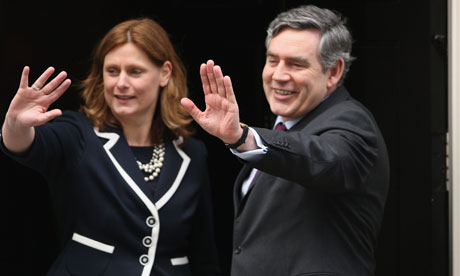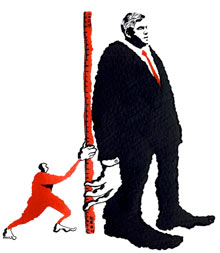A tiny rise in GDP is nothing to celebrate while the UK economy is as dysfunctional as ever

A rise in GDP will be celebrated as proof of George Osborne's wisdom – but the dysfunctions of the UK economy are still firmly in place. Photograph: Rex Features
Next Thursday we will get a further taste of what it is like living in an one-party state. The estimate for GDP growth in the second quarter will be published – predicted to rise between 0.2% and 0.3%, confirmation that a triple dip recession has been avoided and the economy is on the mend. Expect an over-the-top reaction from our centre-right media.
George Osborne's sagacity will be lauded to the skies, and scorn poured on all those who have criticised economic policy or worried about Britain's economic structures. It will be another chance to swing opinion behind the Conservative party – all the more effective because the coverage will reproduce the co-ordination of a government propaganda machine without any formal instruction being given.
Economies are like corks. They have inbuilt upward momentum driven by productivity and population growth. That momentum can be reversed for 18 months or two years in a typical recession when investment and consumption have run ahead of themselves, and of necessity fall back. But like a cork the economy will eventually bounce back to the surface – where it would have been had the recession not happened.
What we are witnessing is that natural bounce – but very weak, extraordinarily slow and no prospect of any substantive follow-through once the economy returns to 2008 levels of output some time next year. What usually takes no more than two years will have taken six – the slowest recovery for more than a century. Exports are effectively unchanged, even to faster growing non-EU countries, despite a 25% devaluation. Company investment has collapsed by 34%. Real wages are 9% below their peak – they rose in every other postwar recession – and are set to fall further. The profound dysfunctions of the British economy, despite wild claims otherwise, remain firmly in place.
What is so dismaying is that hopes that investment and exports would lead recovery have been completely dashed. Instead the British are returning to what they are best at – running down their savings and borrowing enormous mortgages, partially guaranteed by the state under the Help to Buy scheme, to force up house prices.
I did not join the chorus of criticism of Help to Buy when it was launched: it was a clever, time-limited Keynesian use of the public balance sheet to support a distressed part of the economy, and no recovery is conceivable without some rise in house prices rekindling animal spirits and lifting confidence. What was wrong was: to superimpose it upon a market that privileges buyers who want to let rather than own; the Treasury vetoing an extension to lending to business in general; and not recognising that the same Keynesian thinking is needed across the board.
What takes me aback is the determined way the national conversation is skewed towards the inadequacies of the public sector, however concerning – avoidable deaths in the NHS or extravagant pay-offs for BBC executives – without any parallel focus on the inadequacies of the private. The Coronation festival for the Queen was meant to be a celebration of British innovation. Yet there were only three large company pavilions in the Palace gardens – GSK, Bentley and Jaguar Land Rover (owned by the Indian Tata) – and a host of tiny companies dealing in niche luxury goods. The contrast with the industrial and innovative power that could have been mobilised when she began her reign 60 years ago is painful.
Moreover, back then, economic power would have been drawn more equally across the country. There were certainly regional imbalances in the 1950s but compared with today they were trivial. Outside London and the south-east there was no private sector job creation in the decade to 2008. Today these regions possess little more than what Karel Williams of the Centre for Research on Socio-Cultural Change calls a "foundation economy" – the structures that deliver the likes of electricity, food and hospital care but with virtually no private sector entrepreneurial activity. The average size of a British-owned manufacturing company in the regions, he says, is 14 – subcontracting workshops and downmarket complements to those niche luxury companies.
The problem is too few of either develop into companies of any scale. Their owners are too transactional, unsupported or plain greedy, and the financial system that supports them too fickle, disengaged and commission-hungry. Almost no new major British companies have emerged over the past 20 years while dozens that have taken decades to grow have been assimilated into global multinationals, their strategies dictated outside Britain. Some, of course, make a vital contribution to our economy. But this is no basis on which to launch anything but a fitful recovery and weak investment. Yet no fundamental questions are asked.
Instead the Conservative party, and the commentators who support it, live in Fantasy UK, in which the problem is regulation and the EU. The first initiative of David Cameron's new business team in Downing Street has been to ask British businesses to identify those EU regulations most hindering British growth. I conducted my own straw poll in London's Tech City. Brussels and the EU were simply not on the radar. Instead the list included the financial system's aversion to risk, immigration controls keeping out talented foreigners, and BT's inability to provide high-speed broadband.
The debate has to change. Companies in Britain – domestic or foreign-owned – need the prospect of a sustained growth of demand. The governor of the Bank of England, Mark Carney, hinted at establishing a target for growth and inflation combined – nominal GDP – but was beaten back by the austerity defenders. He should stick to his guns. We have to create ownership and financing structures – scaling up the proposed Business Bank fast — that permit companies to grow and stay owned, as far as possible, in Britain. We have to get fundamentally serious about infrastructure. The LSE growth commission's proposal for an interlocking system of infrastructure strategy board, infrastructure bank and independent planning commission is a good starting point. The housing market needs root and branch reform. Above all, there has to be a sense of mobilisation.
But instead we have nonsense babble about the EU being all that is holding us back; huge prizes for essays on EU exit as a focus for intellectual effort (courtesy of the Institution of Economic Affairs); and endless nostalgic festivals and celebrations about world wars one and two. Welcome to Fantasy UK.



